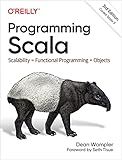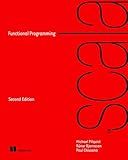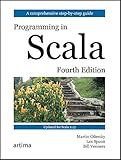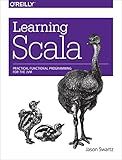Best Scala Programming Books to Buy in December 2025

Programming Scala: Scalability = Functional Programming + Objects



Functional Programming in Scala, Second Edition



Programming in Scala Fifth Edition



Hands-on Scala Programming: Learn Scala in a Practical, Project-Based Way



Programming in Scala



Functional Programming in Scala



Learning Scala: Practical Functional Programming for the JVM


To define a case class in Scala, you use the case class keyword followed by the class name. Here is the general syntax:
case class ClassName(parameters)
A case class is similar to a regular class, but it comes with additional features that make it convenient for modeling immutable data.
- Parameters: You can define constructor parameters for a case class inside the parentheses after the class name. These parameters will be accessible as immutable fields.
- Immutable fields: Each constructor parameter automatically becomes an immutable field in the case class, allowing you to access its value directly.
- toString: Case classes have a toString method that presents a text representation of the class instance. This is useful for debugging or printing values.
- equals and hashCode: Case classes implement equals and hashCode methods, allowing you to compare instances for equality.
- Pattern-matching: Case classes allow effective pattern-matching. You can use the constructor parameters to match specific instances and extract values.
- Companion object: A case class automatically generates a companion object with utility methods. For example, it provides an apply method to conveniently create new instances of the class.
Here's an example of defining a case class to represent a person:
case class Person(name: String, age: Int)
With this definition, you can create instances of the Person class and access their fields:
val john = Person("John Doe", 30) println(john.name) // prints "John Doe" println(john.age) // prints 30
Overall, case classes in Scala simplify working with immutable data by providing convenient syntax and automatically generating useful methods.
How to define a case class with implicit parameters in Scala?
To define a case class with implicit parameters in Scala, you can follow these steps:
- Start by defining your case class as usual with all its fields. For example, suppose we want to define a User case class with name and age fields:
case class User(name: String, age: Int)
- Declare any implicit parameters that you want to use inside the case class. Implicit parameters are declared inside parentheses after the class name. For example, let's declare an implicit parameter logger of type Logger:
case class User(name: String, age: Int)(implicit logger: Logger)
- Use the implicit parameter inside the case class as required. For example, you can use the logger parameter to log information when creating or modifying instances of User:
case class User(name: String, age: Int)(implicit logger: Logger) { def logUser(): Unit = { logger.log(s"User: $name, Age: $age") } }
- Ensure that you have an implicit value of the required type (Logger in our example) in the scope where you use the case class. This can be done by defining an implicit value for the parameter type elsewhere in your code. For example, you can define an implicit value for Logger:
implicit val logger: Logger = new Logger()
With these steps, you have defined a case class with implicit parameters in Scala, allowing you to use these implicit parameters wherever necessary without explicitly passing them as arguments.
What is structural equality in case classes?
Structural equality in case classes refers to the automatic generation of equality methods, such as equals() and hashCode(), based on the structure and content of the case class instances.
In Scala, case classes are a special type of classes that are primarily used for modeling immutable data. They have built-in support for structural equality. When defining a case class, Scala automatically generates an equals() method which compares the values of its fields and a hashCode() method that computes a hash code based on the values of its fields.
This structural equality means that two instances of the same case class will be considered equal if all their corresponding fields have the same values. This behavior is convenient for comparing instances based on their content rather than their reference identity and makes it easier to use case classes in pattern matching, collections, and other operations.
What is the difference between a case class and a sealed trait in Scala?
In Scala, a case class and a sealed trait are two different concepts that serve different purposes.
- Case Class:
- A case class is a class that is primarily used for modeling immutable data. It automatically generates boilerplate code for you, such as equality methods, hash code methods, and pattern matching.
- Case classes are typically used to represent algebraic data types where each instance of the class represents a specific case or variant of the data type.
- Case classes are not supposed to be extended or inherited, although it is technically possible to do so.
- They are often used in pattern matching, where you can easily extract the values of the case class instances using pattern matching syntax.
Example:
case class Person(name: String, age: Int) val p = Person("John", 30) val Person(name, age) = p println(name) // "John"
- Sealed Trait:
- A sealed trait is a trait that can only be extended by classes defined in the same file (also called a sealed trait hierarchy).
- Sealed traits are used together with pattern matching to ensure that all possible cases are handled exhaustively at compile-time.
- When pattern matching on a sealed trait, the compiler will issue a warning if there are any missing cases (unhandled subclasses) of the sealed trait hierarchy.
- Sealed traits are often used in conjunction with case classes to create algebraic data types with exhaustive pattern matching.
Example:
sealed trait Color case object Red extends Color case object Blue extends Color case object Green extends Color
def printColor(color: Color): Unit = color match { case Red => println("Red") case Blue => println("Blue") case Green => println("Green") }
printColor(Blue) // "Blue" printColor(Orange) // Will give a warning about missing case
In summary, case classes are used for modeling immutable data with convenient code generation, while sealed traits are used to create hierarchies of types with exhaustive pattern matching. Sealed traits are often used together with case classes to represent complete algebraic data types.
How to compare instances of case classes in Scala?
In Scala, you can compare instances of case classes using the == operator, as case class instances come with an automatically generated equals method.
Here's an example of comparing two case class instances:
case class Person(name: String, age: Int)
val person1 = Person("Alice", 25) val person2 = Person("Bob", 30) val person3 = Person("Alice", 25)
println(person1 == person2) // Output: false println(person1 == person3) // Output: true
In this example, person1 and person2 are different instances of the Person case class, so their equals method returns false. However, person1 and person3 have the same attribute values, so their equals method returns true.
How to define an unapply() method for custom case class pattern matching?
To define an unapply() method for custom case class pattern matching, you need to implement the unapply() method in the companion object of the case class. Here's an example:
case class Person(name: String, age: Int)
object Person { def unapply(person: Person): Option[(String, Int)] = Some((person.name, person.age)) }
In this example, we defined a case class Person with name and age fields. We then defined the unapply() method in the companion object of the case class. The unapply() method takes a Person object as input and returns an Option containing a tuple of the name and age fields.
Now, you can use pattern matching with Person objects:
val person = Person("John", 30)
person match { case Person(name, age) => println(s"Name: $name, Age: $age") case _ => println("Unknown person") }
When you match a Person object against the Person(name, age) pattern, it will call the unapply() method defined in the companion object to extract the name and age fields.
Output:
Name: John, Age: 30
If the object does not match the pattern, the _ wildcard pattern will match, and you can handle the case accordingly.
Note: The unapply() method can have different parameter signatures based on the pattern you want to match. This example assumes a simple pattern matching against a single case class with two fields.
What is the role of the Product trait in case classes?
The Product trait is one of the two main traits in case classes in Scala, alongside the Serializable trait. The Product trait provides method implementations for various operations such as equality check, pattern matching, and creating string representations for the case class instances.
The Product trait defines the following methods:
- productArity: Returns the number of elements in the case class.
- productElement: Returns the element at a specific index.
- productIterator: Returns an iterator over the elements.
- productPrefix: Returns a string representation of the case class type.
These methods are automatically implemented for case classes when they extend the Product trait. They are used by the compiler for various purposes such as generating equality checks (equals and hashCode methods), pattern matching, and generating string representations (toString method) of case class instances.
By extending the Product trait, case classes inherit these default implementations, which eliminate the need for the developers to write these methods explicitly. This reduces the boilerplate code required for commonly used operations on case classes and makes them more concise and readable.
